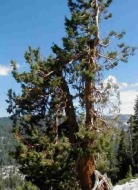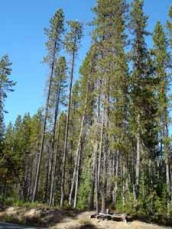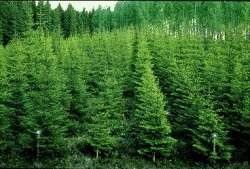2. Subspecies, Varieties, Ecotypes, and Clines
On the previous page, we have looked at adaptation as a characteristic of a species or a group of species. However, there is another important dimension to the concept: adaptation of populations within a species. Temperate tree species tend to be wide-ranging, experiencing a variety of different environments. The range of lodgepole pine, for example, stretches from Alaska to Mexico and populations can be found from sea level to well above 3000m elevation. It would be impossible for a lodgepole pine seedling collected from the Pacific coast to survive in Alberta because it is not adapted to the much colder winter conditions here.

Adaptation of populations within a species to different environments can lead to the formation of subspecies, varieties, ecotypes, or populations of a cline. All these subdivisions can also be referred to as genotypes because they are genetically distinct.
The term subspecies is typically used for geographically isolated populations of a species (e.g. by oceans or mountain ranges). Subspecies show clearly visible differences in morphology, but they are still capable of interbreeding (i.e. the evolutionary speciation process is not quite complete).
The term subspecies is typically used for geographically isolated populations of a species (e.g. by oceans or mountain ranges). Subspecies show clearly visible differences in morphology, but they are still capable of interbreeding (i.e. the evolutionary speciation process is not quite complete).

Varieties also show visible differences in some traits, but the differences tend to be less pronounced than for subspecies. Varieties are also not always geographically isolated. Lodgepole pine, for example, is subdivided into four varieties: shorepine on the Pacific coast (right image), the rocky mountain variety of the interior (left image), as well as two other varieties in California and Nevada.
The term ecotype is used for at least somewhat geographically isolated (disjunct) populations of a species with limited genetic exchange through pollen and seed. The populations are not visibly different but there are physiological adaptations to different environments. In an evolutionary context, ecotypes can be thought of as an early stage of speciation, potentially leading to different subspecies, or even to different species under continued isolation and selection.
The term ecotype is used for at least somewhat geographically isolated (disjunct) populations of a species with limited genetic exchange through pollen and seed. The populations are not visibly different but there are physiological adaptations to different environments. In an evolutionary context, ecotypes can be thought of as an early stage of speciation, potentially leading to different subspecies, or even to different species under continued isolation and selection.

There is another type of genetic structure when adaptation occurs along an environmental gradient within the range of a species. This is called a cline. Populations of a cline are not geographically isolated, and gene flow among populations prevents major differentiation or speciation. Clines can be found along elevational or latitudinal gradients. Populations of a cline are adapted to conditions along this environmental gradient.
While populations of clines and ecotypes are not visibly different in natural populations, their adaptations can be investigated in provenance trials, where seedlings from different locations are grown in a common environment to reveal genetic differences.
While populations of clines and ecotypes are not visibly different in natural populations, their adaptations can be investigated in provenance trials, where seedlings from different locations are grown in a common environment to reveal genetic differences.